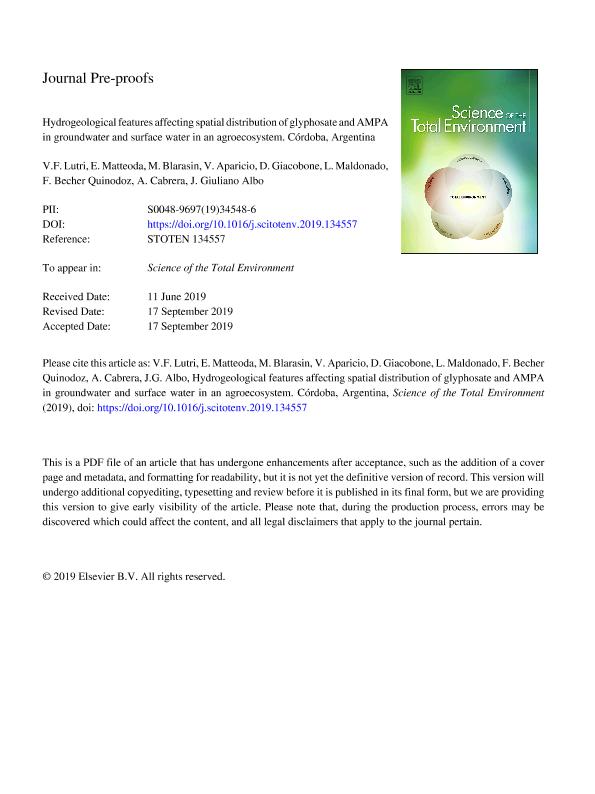Artículo
Hydrogeological features affecting spatial distribution of glyphosate and AMPA in groundwater and surface water in an agroecosystem. Córdoba, Argentina
Lutri, Veronica Florencia ; Matteoda, Edel Mara; Blarasin, Mónica Teresa; Aparicio, Virginia Carolina
; Matteoda, Edel Mara; Blarasin, Mónica Teresa; Aparicio, Virginia Carolina ; Giacobone, Daniela Beatriz
; Giacobone, Daniela Beatriz ; Maldonado, Luciana; Bécher Quinodóz, Fátima Noelia
; Maldonado, Luciana; Bécher Quinodóz, Fátima Noelia ; Cabrera, Adriana Edith; Giuliano Albo, María Jesica
; Cabrera, Adriana Edith; Giuliano Albo, María Jesica
 ; Matteoda, Edel Mara; Blarasin, Mónica Teresa; Aparicio, Virginia Carolina
; Matteoda, Edel Mara; Blarasin, Mónica Teresa; Aparicio, Virginia Carolina ; Giacobone, Daniela Beatriz
; Giacobone, Daniela Beatriz ; Maldonado, Luciana; Bécher Quinodóz, Fátima Noelia
; Maldonado, Luciana; Bécher Quinodóz, Fátima Noelia ; Cabrera, Adriana Edith; Giuliano Albo, María Jesica
; Cabrera, Adriana Edith; Giuliano Albo, María Jesica
Fecha de publicación:
01/04/2020
Editorial:
Elsevier Science
Revista:
Science of the Total Environment
ISSN:
0048-9697
Idioma:
Inglés
Tipo de recurso:
Artículo publicado
Clasificación temática:
Resumen
The study area is located in the eastern slope of Las Peñas Mountain and its adjacent oriental fluvio-aeolian-plain. Agriculture is the main activity (soybean, maize, wheat, peanuts and alfalfa) with no-tillage farming and intensive use of agrochemicals (pesticides-fertilizers). Glyphosate (N-phosphono-methylglycine) is the most common used herbicide which suffers microbial biodegradation giving aminomethylphosphonic acid (AMPA), its main metabolite. The objective of this work is to evaluate hydrogeological features which influence the presence of glyphosate and AMPA in waters. In the study area, the main flow direction of surface and groundwater is NW-SE. The unsaturated zone thickness decreases in the same direction from 60 to 0 m, so groundwater surges in low areas in the eastern sector. From the total water samples collected, glyphosate was detected in 66% of surface water samples (0.2 to 167.4 μg/L), in 15.8% of the groundwater samples (1.3 to 2 μg/L) and in the harvested precipitation sample (0.2 μg/L). AMPA was found in 33% of surface water and 15.8% of groundwater. The herbicide detection was related to areas with the shallowest water table (< 4 m), low hydraulic conductivity in the aquifer (K = 1.5 m/d), low hydraulic gradient (i = 0.16%) and very low flow velocity (0.02 m/d). The most outstanding result is that the groundwater presents higher values in comparison with the surface water samples, which can be explained by the greater dilution capacity of streams. The detection of glyphosate and AMPA in the unconfined aquifer shows that the application for decades under the prevailing agricultural model exceeds the degradation potential of the soil and the unsaturated zone, causing groundwater contamination.
Archivos asociados
Licencia
Identificadores
Colecciones
Articulos(CCT - CORDOBA)
Articulos de CTRO.CIENTIFICO TECNOL.CONICET - CORDOBA
Articulos de CTRO.CIENTIFICO TECNOL.CONICET - CORDOBA
Citación
Lutri, Veronica Florencia; Matteoda, Edel Mara; Blarasin, Mónica Teresa; Aparicio, Virginia Carolina; Giacobone, Daniela Beatriz; et al.; Hydrogeological features affecting spatial distribution of glyphosate and AMPA in groundwater and surface water in an agroecosystem. Córdoba, Argentina; Elsevier Science; Science of the Total Environment; 711; 134557; 1-4-2020; 1-51
Compartir
Altmétricas



